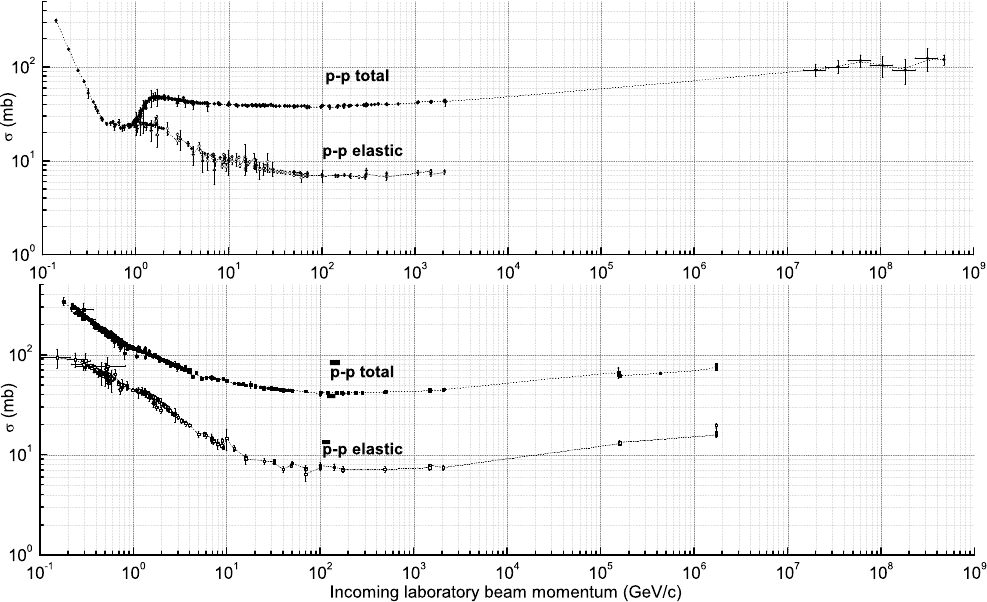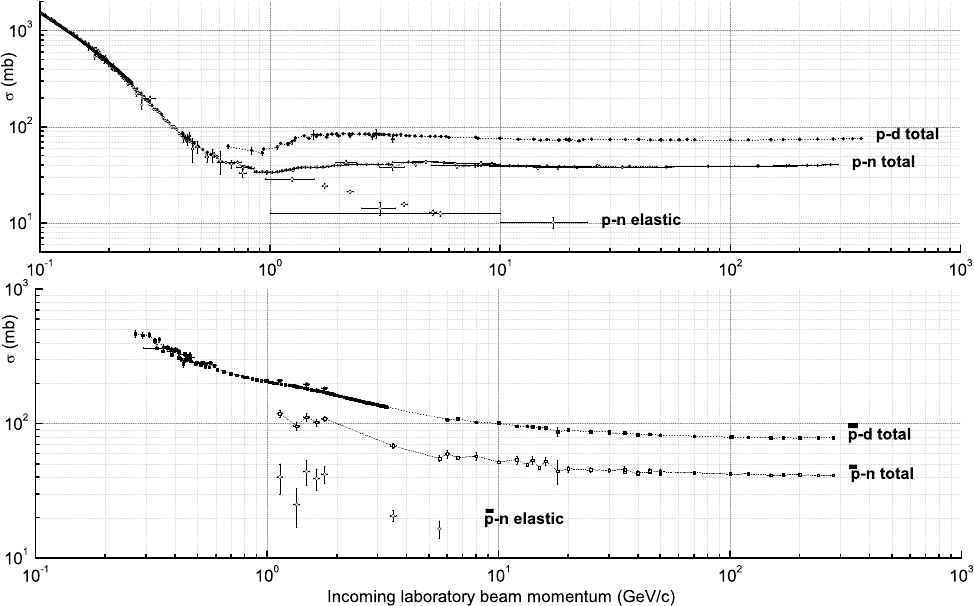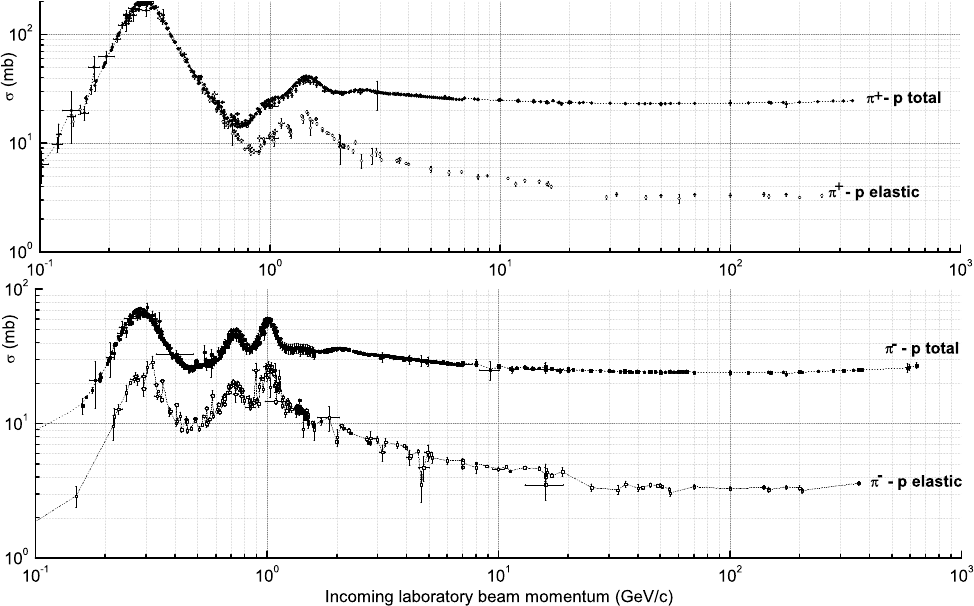Leroy C., Rancoita P.-G. Principles Of Radiation Interaction In Matter And Detection
Подождите немного. Документ загружается.

January 9, 2009 10:21 World Scientific Book - 9.75in x 6.5in ws-bo ok975x65˙n˙2nd˙Ed
240 Principles of Radiation Interaction in Matter and Detection
ing a pair of bound nucleons, i.e., it requires ≈ (1–2) MeV. Even-even nuclei with
M
A
> 20 may require more than 2 MeV. Even-odd and odd-odd nuclei have many
lower excited states of about 100 keV. The electromagnetic radiation emitted by the
decay of lower excited energy states can be interpreted as given by a superposition
of electric dipole, quadrupole, octopole and other multi-pole transitions (see [Segre
(1977); Povh, Rith, Scholz and Zetsche (1995)]), which have different angular di-
stributions and are indicated by E
1
, E
2
, E
3
, etc.. The corresponding multipole
magnetic transitions are called M
1
, M
2
, M
3
, etc.. The angular momentum and
parity conservations determine angular momentum and parity selection rules. The
treatment of the multipole transition probability is rather complicated and still
rather approximative (see, for instance, Chapter 9 in [Marmier and Sheldon (1969)]
and references therein).
When γ-decay is so much inhibited by forbidden transitions that the mean life-
time of the excited state exceeds 0.1 s, this long-lived nuclear state is called isomeric
state, as already mentioned at page 226. Isomeric states have typically large spin
differences and small energy differences from lower-lying energy levels. They are
labeled with a small m following the mass number value. For example, we have the
99m
Tc nuclide which has a lifetime of ≈ 6 h and decays by emitting a photon of
140.5 keV. This nuclide is largely used in nuclear medicine.
Some nuclear γ-ray and intensity standards from [IAEA (1991, 1998)], recom-
mended by the IAEA Coordinate Research Programme (CRP) for calibration of
γ-ray measurements, are given in Appendix A.8. Further X- and γ-ray data are
available from [IAEA (1991, 1998); ToI (1996, 1998, 1999); Helmer (1999); Helmer
and van der Leun (1999, 2000)].
3.2 Phenomenology of Interactions on Nuclei at High Energy
In Sect. 3.1, we treated the general properties and models of nuclei without consider-
ing any specific reaction on nuclei. These nuclear properties are due to short-ranged
nuclear forces, which, in turn, have their origin in strong interactions among nu-
cleons. Moreover, in addition to the electromagnetic interactions discussed in the
chapter on Electromagnetic Interaction of Radiation in Matter, hadronic particles
like protons (p) and pions (π) also undergo strong interactions on their passage in
matter. At high energies, among the resulting effects of strong interactions, there
are particle creation and nuclear breakup.
Hadronic interactions on protons were widely studied in high-energy physics
experiments, during many decades, in order to investigate the fundamental con-
stituents of the so-called elementary particles, like the proton itself and the neu-
tron. Because the nucleus is made of nucleons, it has become standard to express the
relevant characteristics of the hadronic production on nuclei, in terms of ratios to
the corresponding quantities observed in hadronic production on nucleons, i.e., on
protons.

January 9, 2009 10:21 World Scientific Book - 9.75in x 6.5in ws-bo ok975x65˙n˙2nd˙Ed
Nuclear Interactions in Matter 241
Among the salient features of the hadroproduction (and photoproduction) on
nuclei from a few GeV up to very high energies, there is the coherent production [≈
(8–12)% of the total cross section]. The coherent reactions are interactions where
the nucleus remains in its ground state after the collision has occurred. Furthermore,
as discussed in Sect. 3.2.2, there is no evidence of a large intranuclear cascade on
multiparticle incoherent production on nuclei (see for instance [Feinberg (1972);
Busza (1977); Otterlund (1977); Halliwell (1978); Otterlund (1980)] and references
therein). For many years, experimental data on hadro- and photo-production on
nuclei were obtained using photographic emulsions exposed to high, very high and
ultra-high energy cosmic rays. In the last few decades, accelerator experiments were
carried out on both coherent and incoherent production on nuclei, as well.
It has to be noted that experiments on relativistic heavy-ion collisions were also
performed, but this topic
∗∗
is beyond the purpose of the present book.
3.2.1 Energy and A-Dependence of Cross Sections
We already discussed, in the chapter on Electromagnetic Interaction of Radiation
in Matter, how most of the electromagnetic differential cross sections are strongly
peaked in the forward direction and fall off as the energy increases. Away from the
forward direction, the high-energy behavior is mostly dominated by the hadronic
strong-interaction properties. However, in the forward direction, strong-interaction
processes like quasi-elastic and coherent production are relevant at high energies.
The dependence of the total and elastic cross sections of proton (p) and anti-
proton (¯p) on proton is shown in Fig. 3.9 versus the incoming laboratory momentum
in GeV/c [PDB (2002)]. The main differences on the cross-section behavior appear
at incoming particle momenta lower than 2–3 GeV/c. For incoming momenta <
1 GeV/c, the p–p scattering is dominated by the elastic scattering, which is still
a relevant fraction, ≈ (15–20)%, of the total cross section at higher energies. At
incoming energies of ≈ 200–300 GeV, the total p–p cross section is about 38–40 mb
and increases almost logarithmically with s, where s (see page 12) is the square
of the total energy in the center-of-mass system divided by c
2
. At high-energies,
the elastic scattering is a relevant fraction of the total cross section for p–n and
¯p–n (see Fig. 3.10), and, also, in π
±
–p (see Fig. 3.11) scatterings. Furthermore, the
interaction of p and ¯p on the lightest bound nuclide, the deuterium (d), indicates
again similar general features (Fig. 3.10).
Total cross sections on nuclei were measured by various experiments (see for
instance [Murthy et al. (1975); Busza (1977); Carroll et al. (1979); Roberts et al.
(1979)]). The experimental data show that, above 20 GeV, cross sections exhibit
a weak energy-dependence [Fernow (1986)]. Complex multi-step processes, asso-
ciated with an increased nuclear-matter transparency
‡‡
(Sect. 3.2.2) to particles
∗∗
The reader can see Section 16.4 of [Henley and Garcia (2007)], as a short introduction to this
topic, and recent reviews like, for instance, [Ludlam (2005); M¨uller and Nagle (2006)].
‡‡
The reader can see [Rancoita and Seidman (1982)] and references therein.

January 9, 2009 10:21 World Scientific Book - 9.75in x 6.5in ws-bo ok975x65˙n˙2nd˙Ed
242 Principles of Radiation Interaction in Matter and Detection
produced in the primary interaction on nucleons, can be partially responsible for
the weakening of the cross-section energy-dependence. When propagation in matter
is considered, the more relevant cross section is the so-called inelastic cross section,
which is defined as:
σ
A(inel)
= σ
A,tot
− σ
A,el
− σ
A,q−el
, (3.32)
where σ
A,tot
refers to the total cross section on the nucleus with atomic weight
¶
A, σ
A,el
refers to coherent elastic scattering off the whole nucleus (Sect. 3.2.2)
and σ
A,q−el
refers to the quasi elastic process on individual nucleons, in which no
additional fast secondary particle is produced but the nucleus might be disrupted. It
was determined in neutron–nucleus (n–A) interactions that for A ≥ 9 [Rob erts et
al. (1979)]:
σ
nA(inel)
' 41.2A
0.711
[mb], (3.33)
while the total cross section goes as ∼ A
0.77
. It has to be noted that, for the
nuclear radius value given by Eq. (3.12), we expect that the geometrical cross sec-
tion is approximatively proportional to r
2
n
(Sect. 1.4), i.e., proportional to A
2/3
(Sects. 3.1, 3.1.1). Furthermore, the proton–nucleus (p–A) and pion–nucleus (π–A)
inelastic cross sections are given by ([Busza (1977)] and references therein):
σ
pA(inel)
' 46A
0.69
[mb], (3.34)
σ
π A(inel)
' 28.5A
0.75
[mb]. (3.35)
Finally, in interactions on nuclei, the absorption cross section is defined as
([Roberts et al. (1979)] and references therein):
σ
A(absorption)
= σ
A(inel)
+ σ
A,q−el
= σ
A,tot
− σ
A,el
. (3.36)
3.2.1.1 Collision and Inelastic Length
In Sect. 1.4, we introduced the collision length λ
col
as the mean free path between
successive interactions occurring for processes whose total cross section is σ
tot
. In
the case of strong interactions on nuclei, we define the nuclear inelastic length (λ
inel
)
as the mean free path between successive inelastic collisions whose cross section is
given by Eq. (3.32). By rewriting Eq. (1.41), we have:
λ
inel
=
A
Nρ σ
A(inel)
[cm] (3.37)
where A is the atomic weight, N is the Avogadro constant (see Appendix A.2),
σ
A(inel)
is in cm
2
and ρ in g/cm
3
.
¶
As discussed at page 220, to a first approximation, the atomic weight, A (also referred to as
relative atomic mass, see page 15), of a nuclide is expressed by its mass number.

January 9, 2009 10:21 World Scientific Book - 9.75in x 6.5in ws-bo ok975x65˙n˙2nd˙Ed
Nuclear Interactions in Matter 243
Fig. 3.9 Total and elastic cross sections of p and ¯p on p as a function of the incoming beam momentum (experimental data and references are
available, also via the web, from [PDB (2002)]). The lines are to guide the eye.

January 9, 2009 10:21 World Scientific Book - 9.75in x 6.5in ws-bo ok975x65˙n˙2nd˙Ed
244 Principles of Radiation Interaction in Matter and Detection
Fig. 3.10 Total and elastic cross sections of p and ¯p on d and n as a function of the incoming beam momentum (experimental data and references
are available, also via the web, from [PDB (2002)]). The lines are to guide the eye.

January 9, 2009 10:21 World Scientific Book - 9.75in x 6.5in ws-bo ok975x65˙n˙2nd˙Ed
Nuclear Interactions in Matter 245
Fig. 3.11 Total and elastic cross sections of π
±
on p as a function of the incoming beam momentum (experimental data and references are available,
also via the web, from [PDB (2002)]). The lines are to guide the eye.
January 9, 2009 10:21 World Scientific Book - 9.75in x 6.5in ws-bo ok975x65˙n˙2nd˙Ed
246 Principles of Radiation Interaction in Matter and Detection
3.2.2 Coherent and Incoherent Interactions on Nuclei
In spite of the (large) numb er of nucleons involved, the interaction with nuclei is
more simple to deal with than interactions with a nucleon, when the nucleus remains
in its ground state after the interaction. This kind of interaction is called coherent
interaction on nucleus, i.e.,
h + T
N
→ h
∗
+ T
N
.
A coherent nuclear reaction is an interaction induced by a high energy particle, in
which all nucleons, whose amplitudes have strong interference-effects, are partici-
pating. The theory of coherent reaction on nuclei was derived by Glauber (see, for
instance, [Glauber (1959)] and references therein).
The concept that particle production can occur diffractively, namely coherently,
from a nucleus, was first introduced by Feinberg and Pomeranchuk (1956), who
pointed out that, at large incoming particle momenta, a minimum momentum
transfer, q
m
, can be sufficient to produce a final hadronic state with a mass larger
than the incoming one, when the wavelength h/q
m
is comparable to or larger than
the nuclear size. Hence, owing to the uncertainty principle [Eq. (3.25)], the effec-
tive dimensions of the region involved can be large compared with the target di-
mensions. This process was called the diffraction dissociation process or diffractive
reaction. Furthermore, the possibility of nuclear excitation in diffractive collisions
can be understood by considering that, if the exchanged momentum is capable of
changing the initial particle mass by several hundred MeV/c
2
(or a few GeV/c
2
),
it should easily allow the target nucleus to acquire a few MeV. Reactions in which
the recoil nucleus is a well-defined excited state are called semi-coherent reactions
(e.g., [Stodolsky (1966)] and references therein), like for instance:
h +
12
C → h
∗
+
12
C(2
+
)
and, subsequently,
12
C(2
+
) →
12
C + γ(4.4MeV).
3.2.2.1 Kinematics for Coherent Condition
Let us consider the production reaction:
h + T
N
→ h
∗
+ R
N
. (3.38)
In this reaction,
˜
h =
³
E/c,
~
h
´
,
˜
T
N
= (M
N
c, 0) ,
˜
h
∗
=
³
E
∗
/c,
~
h
∗
´
,
˜
R
N
= (E
R
/c, ~q)
are the four-momenta of the incoming particle, the target nucleus at rest, the
diffracted particle and the recoil nucleus, whose rest masses are m
h
, M
T
, m
h
∗
,

January 9, 2009 10:21 World Scientific Book - 9.75in x 6.5in ws-bo ok975x65˙n˙2nd˙Ed
Nuclear Interactions in Matter 247
M
R
and whose momenta are
~
h, 0,
~
h
∗
, ~q, respectively. From energy-momentum con-
servation, the four-momenta transfer squared, t (defined at page 12), between h and
h
∗
and between T
N
and R
N
must be equal, namely:
t =
³
˜
h −
˜
h
∗
´
2
=
³
˜
T
N
−
˜
R
N
´
2
= T
2
N
+ R
2
N
− 2
˜
R
N
·
˜
T
N
= M
2
T
c
2
+ M
2
R
c
2
− 2M
T
E
R
. (3.39)
For a coherent reaction, i.e., when M
T
= M
R
and E
R
' q
2
/ (2 M
R
), we have
E
R
= M
R
c
2
+
q
2
2M
R
and we can rewrite Eq. (3.39) as:
−t ' q
2
= q
2
k
+ q
2
⊥
, (3.40)
where |q
k
| and |q
⊥
| are the longitudinal and transverse three-momentum transfer,
respectively. Because the incoming momentum is along the longitudinal direction,
the transverse three-momentum transfer can be arbitrarily small (at the limit to
become zero). Thus, in a coherent reaction, the value of
q
2
k
≡ −t
min
(3.41)
is kinematically the minimum four-momentum transfer from the target to the re-
coiling nucleus to produce the particle h
∗
by an incoming particle h. Furthermore,
in coherent reactions the differential cross section, which depends on the four mo-
mentum transfer, is usually expressed as a function of the quantity t
0
defined as:
t
0
≡ |t − t
min
| = q
2
⊥
. (3.42)
In order to estimate t
min
, we need first to evaluate the limits on the momentum
transfer imposed by the coherent condition.
Let us consider the diffraction scattering in the framework of the optical model
(e.g. see [Roman (1965); Fisher (1968)]), first developed for the elastic scattering. In
this model, the complete interacting system is assumed in complete stationary mode
and the time dependence of the wave function is omitted. The incident particle beam
moving in the positive z direction is described by a plane wave
Ψ
in
= exp(ik
p
z),
where k
p
= p/~ is the wave vector, i.e., the particle momentum p in units of ~.
At large distances from the scattering center, the scattered wave is an outgoing
spherical wave described by
Ψ
scat
= f(θ)
exp (ik
p
r)
r
, (3.43)
where k
p
is the wave vector of the outgoing particle after elastic scattering, θ is the
scattering angle, r is radial distance from the scattering center, f (θ) is the scattering
amplitude, whose related angular differential cross section is given by:
dσ
dΩ
= |f(θ)|
2
.

January 9, 2009 10:21 World Scientific Book - 9.75in x 6.5in ws-bo ok975x65˙n˙2nd˙Ed
248 Principles of Radiation Interaction in Matter and Detection
The solution of Schr¨odinger’s equation, when the scattered wave is given by Ψ
scat
,
allows one to establish a relationship (the so-called optical theorem) between the
total cross section and the imaginary part of the scattering amplitude in the forward
direction:
Imf(θ = 0) =
k
p
4π
σ
tot
. (3.44)
In addition, it can be shown (see, for instance, [Fisher (1968); Bingham (1970)]
and references therein) that, in order to produce coherently a diffracted wave on a
nuclear target, the phase difference between the outgoing diffracted wave and the
incident wave is ' (2r
n
q
k
)/~, where r
n
is the radius of the nucleus [Eq. (3.12)],
and must be lower than π. Then, we can have a constructive interference between
contributions from all positions, from the front to the back of the nucleus of diameter
2r
n
. Therefore, the coherent condition for the interaction on a nucleus is satisfied
when:
2r
n
q
k
~
≤ π ⇒ q
k
≤ ~
π
2r
n
. (3.45)
By taking a factor ∼ 2 lower for the right hand side of Eq. (3.45), the coherent
condition is even better satisfied. Since numerically we have
~c ' 197.3 MeV fm,
m
π
c
2
= 139.6 MeV
(where m
π
is the rest mass of the pion), and
~c
m
π
c
2
=
~
m
π
c
' 1.4 fm,
we can write the practical coherent condition, as:
q
k
≤
1
2
µ
~
π
2r
n
¶
∼
4.4 m
π
c
4.8 M
1/3
A
'
m
π
c
M
1/3
A
∼
m
π
c
A
1/3
[MeV/c], (3.46)
where m
π
is in units of MeV/c
2
and the mass number of the target nucleus (M
A
)
is numerically approximated by the atomic weight (A) of the nuclide (see Sect. 3.1
and, also, the discussion at page 220)
M
A
∼ A.
Let us evaluate the value of t
min
for the reaction shown in Eq. (3.38) for a high
energy coherent scattering, induced by an incoming particle of momentum p. We
have for q
⊥
= 0:
t
min
= −q
2
k
= −q
2
=
³
˜
h −
˜
h
∗
´
2
= m
2
h
c
2
+ m
2
h
∗
c
2
− 2
E
c
"
E
c
−
1
c
Ã
q
2
k
2M
R
!#
+ 2p (p − q
k
), (3.47)

January 9, 2009 10:21 World Scientific Book - 9.75in x 6.5in ws-bo ok975x65˙n˙2nd˙Ed
Nuclear Interactions in Matter 249
where E −(q
2
k
/2M
R
) and p −q
k
are the energy and longitudinal momentum of the
diffracted hadron h
∗
, respectively. In a coherent scattering, q
k
is small
∗
and, thus,
the term (q
2
k
/2M
R
) can be neglected. Introducing Eq. (1.8), the expression (3.47)
becomes
−q
2
k
∼ m
2
h
c
2
+ m
2
h
∗
c
2
− 2
¡
p
2
+ m
2
h
c
2
¢
+ 2p
2
− 2p q
k
= m
2
h
∗
c
2
− m
2
h
− 2p q
k
= m
2
h
∗
c
2
− m
2
h
c
2
− 2p q
k
,
and, finally, by neglecting q
2
k
with respect to 2p q
k
, we have:
p
| − t
min
| = q
k
∼
m
2
h
∗
c
2
− m
2
h
c
2
2p
. (3.48)
For instance, from Eq. (3.46), in interactions on C and Pb nuclei, the coherently
limited q
k
values are ≈ 61 and 24 MeV/c, respectively, within a factor 2. While from
Eq. (3.48) at an incoming particle momentum of 25 GeV/c, the largest masses of
particles coherently produced are ≈ 1.75 and 1.10 GeV/c
2
, respectively, within a
factor
√
2.
The coherent condition given in Eq. (3.46) has to be applied also to the transverse
momentum transfer q
⊥
. Thus, the coherent production in a forward cone is limited
by:
θ
coh
∼
m
π
c
M
1/3
A
µ
1
p
¶
∼
m
π
c
A
1/3
µ
1
p
¶
.
For instance, the coherent production on C and Pb nuclei at an incoming momentum
of 25 GeV/c is almost limited to the angles θ
coh
of ≈ 2.4 and 1 mrad, respectively.
3.2.2.2 Coherent and Incoherent Scattering
In this section, we will employ relativistic units used for calculations, i.e., all quan-
tities are express in units so that
~ = c = 1.
The masses are measured in GeV, i.e., the mass of the proton is ' 0.938 GeV. Be-
cause in the International System of Units ~c ' 0.1973 GeV fm, the conversion
factor of the unit of length to cm becomes 1.973 × 10
−14
cm. If the unit of mass
were chosen differently, for instance the proton mass, the conversion factor to cm
would be modified accordingly. Furthermore, for a compact notation the number of
nucleons in a nucleus is indicated with that for the atomic weight
¶
A, instead of
the usual symbol M
A
.
The coherent elastic scattering on nuclei was first introduced within the frame-
work of Glauber’s multiple scattering theory. This high-energy approach assumes i)
∗
The largest practical value of q
k
can be estimated using Eq. (3.46).
¶
As discussed at page 220, to a first approximation the atomic weight (also referred to as relative
atomic mass, see page 15) of a nuclide is expressed by its mass number.
